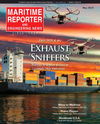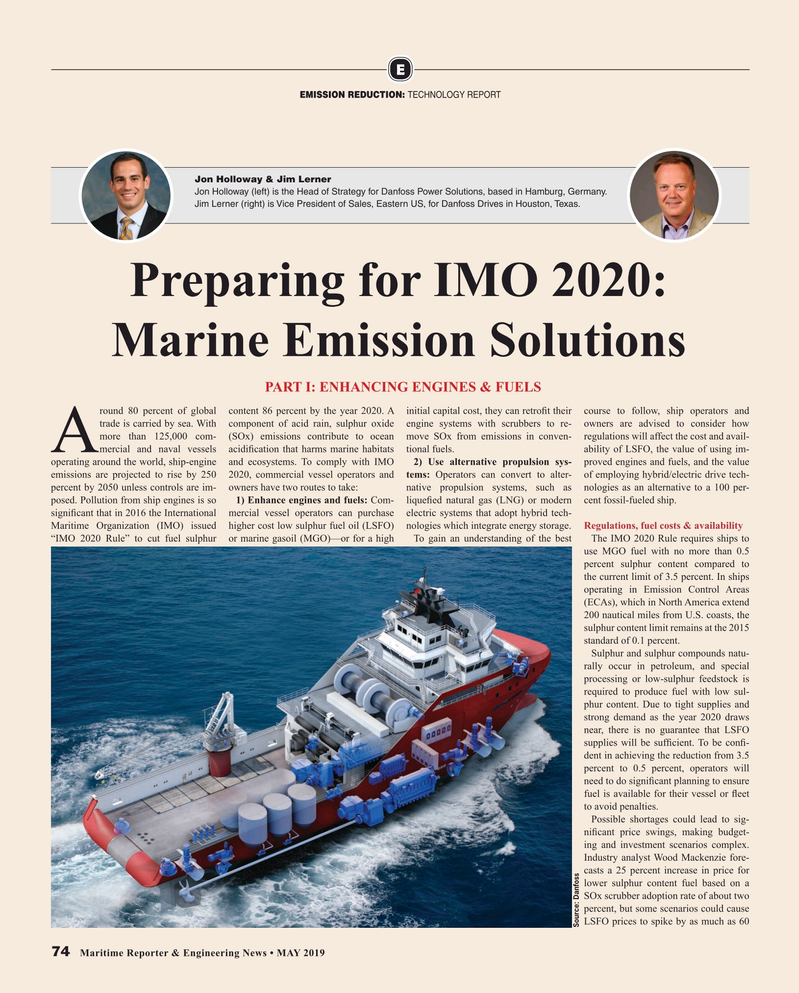
Page 74: of Maritime Reporter Magazine (May 2019)
Propulsion Annual - Green Marine Tech
Read this page in Pdf, Flash or Html5 edition of May 2019 Maritime Reporter Magazine
E
EMISSION REDUCTION: TECHNOLOGY REPORT
Jon Holloway & Jim Lerner
Jon Holloway (left) is the Head of Strategy for Danfoss Power Solutions, based in Hamburg, Germany.
Jim Lerner (right) is Vice President of Sales, Eastern US, for Danfoss Drives in Houston, Texas.
Preparing for IMO 2020:
Marine Emission Solutions
PART I: ENHANCING ENGINES & FUELS round 80 percent of global content 86 percent by the year 2020. A initial capital cost, they can retro? t their course to follow, ship operators and trade is carried by sea. With component of acid rain, sulphur oxide engine systems with scrubbers to re- owners are advised to consider how more than 125,000 com- (SOx) emissions contribute to ocean move SOx from emissions in conven- regulations will affect the cost and avail-
Amercial and naval vessels acidi? cation that harms marine habitats tional fuels. ability of LSFO, the value of using im- operating around the world, ship-engine and ecosystems. To comply with IMO 2) Use alternative propulsion sys- proved engines and fuels, and the value emissions are projected to rise by 250 2020, commercial vessel operators and tems: Operators can convert to alter- of employing hybrid/electric drive tech- percent by 2050 unless controls are im- owners have two routes to take: native propulsion systems, such as nologies as an alternative to a 100 per- posed. Pollution from ship engines is so 1) Enhance engines and fuels: Com- lique? ed natural gas (LNG) or modern cent fossil-fueled ship.
signi? cant that in 2016 the International mercial vessel operators can purchase electric systems that adopt hybrid tech-
Maritime Organization (IMO) issued higher cost low sulphur fuel oil (LSFO) nologies which integrate energy storage. Regulations, fuel costs & availability “IMO 2020 Rule” to cut fuel sulphur or marine gasoil (MGO)—or for a high To gain an understanding of the best The IMO 2020 Rule requires ships to use MGO fuel with no more than 0.5 percent sulphur content compared to the current limit of 3.5 percent. In ships operating in Emission Control Areas (ECAs), which in North America extend 200 nautical miles from U.S. coasts, the sulphur content limit remains at the 2015 standard of 0.1 percent.
Sulphur and sulphur compounds natu- rally occur in petroleum, and special processing or low-sulphur feedstock is required to produce fuel with low sul- phur content. Due to tight supplies and strong demand as the year 2020 draws near, there is no guarantee that LSFO supplies will be suf? cient. To be con? - dent in achieving the reduction from 3.5 percent to 0.5 percent, operators will need to do signi? cant planning to ensure fuel is available for their vessel or ? eet to avoid penalties.
Possible shortages could lead to sig- ni? cant price swings, making budget- ing and investment scenarios complex.
Industry analyst Wood Mackenzie fore- casts a 25 percent increase in price for lower sulphur content fuel based on a
SOx scrubber adoption rate of about two percent, but some scenarios could cause
LSFO prices to spike by as much as 60
Source: Danfoss 74 Maritime Reporter & Engineering News • MAY 2019
MR #5 (74-81).indd 74 5/2/2019 4:06:08 PM

 73
73

 75
75
